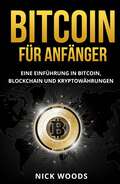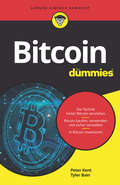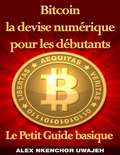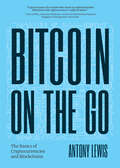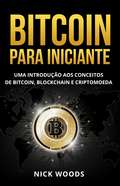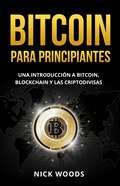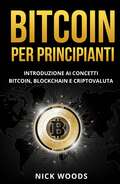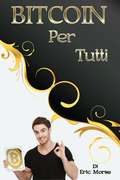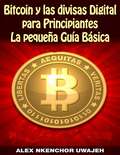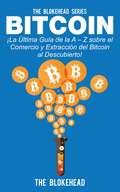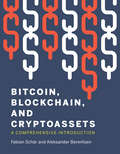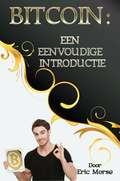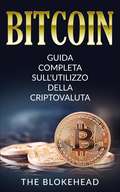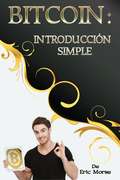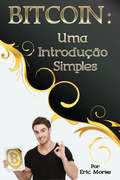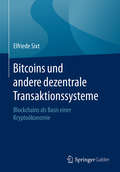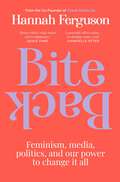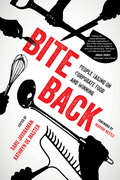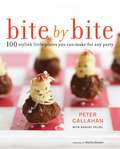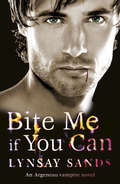- Table View
- List View
Bitcoin für Anfänger: Eine Einführung in Bitcoin, Blockchain und Kryptowährungen
by Nick WoodsMöchten Sie lernen, wie Sie von der Bitcoin-Revolution profitieren können? Haben Sie in letzter Zeit in den Nachrichten von Bitcoin gehört und können sich nicht vorstellen, was Bitcoin ist? Fragen Sie sich, wie Sie anfangen können, in Bitcoin zu investieren, verstehen aber nicht wirklich, was Bitcoin eigentlich genau ist, und zögern, in etwas zu investieren, das Sie nicht verstehen? Wünschen Sie sich, Sie könnten Bitcoin verstehen, haben aber Angst, dass das Thema zu komplex und zu kompliziert ist? Haben Sie nach einem Buch gesucht, das Ihnen hilft, Bitcoin zu verstehen, damit Sie ohne Angst in Kryptowährungen investieren können? Wenn das nach Ihnen klingt, dann haben Sie das richtige Buch gefunden! Bitcoin ist eine faszinierende dezentrale Währung, die nur online verfügbar ist und es dem Benutzer ermöglicht, relativ anonym zu sein. Es ist eine digitale Währung, die von jedem, der mit dem Internet verbunden ist, verwendet werden kann und unabhängig von der Region ist. Sie bewahren Bitcoin in einer elektronischen „Wallet“ auf, ähnlich wie Sie Ihr Geld in Ihrer Brieftasche haben oder in eine Bank einzahlen. Dies wird alles elektronisch betrieben und es ist kein Fiat-(Papier)geld beteiligt. Wenn Sie Bitcoin verstehen, wird Ihnen das helfen, mit der Kryptowährung alle Ihre Investitionsziele zu erreichen, egal wie groß oder klein die sind. Unabhängig davon, wer Sie sind und was Sie erreichen möchten, die Basis von Bitcoin ist für alle gleich. Dieses Buch wird Ihnen helfen, alles zu verstehen, was Sie über Bitcoin, Blockchain und Kryptowährungen wissen müssen, einschließlich der Vorteile und Herausforderungen der neuen Technologie. Es ist eine Schritt-für-Schritt-Anleitung, damit Sie ein besseres Verständnis für Bitcoin und andere Kryptowährungen bekommen. In diesem Buch werden Sie Folgendes lernen: Was genau Bitcoin ist Warum Bitcoin wichtig ist Vergleich vo
Bitcoin für Dummies (Für Dummies)
by Peter Kent Tyler BainBitcoin bieten Ihnen neue Möglichkeiten, wie Sie Ihr Geld anlegen und grundlegende Transaktionen im Zahlungsverkehr durchführen können. Der erste Schritt in die Welt der Kryptowährungen kann jedoch verwirrend und einschüchternd sein. Dieses Buch ist Ihre Orientierungshilfe: Peter Kent und Tyler Bain erklären Ihnen die technischen Hintergründe und zeigen Ihnen, wie Sie Bitcoin kaufen, eine Wallet erstellen und mit Bitcoin bezahlen. Auà erdem erfahren Sie, was Sie bei der Investition in Bitcoin beachten müssen und wie Sie sich vor Betrügern schützen.
Bitcoin la devise numérique pour les débutants: Le Petit Guide basique
by Mohammad Mostafa Alex Nkenchor UwajehCe livre vous donnera un aperçu de ce qui sont les Bitcoins et d'où ils viennent. Il vous expliquera comment Bitcoins peuvent être utilisés, où vous pouvez les obtenir, et comment Bitcoin se compare à l'argent réel. Vous découvrirez aussi comment le processus fonctionne Bitcoin, de sorte que vous pouvez obtenir votre propre portefeuille a commencé. De télécharger le logiciel, à l'obtention et à l'aide d'une adresse, vous découvrirez tout ce qu'il y a à savoir sur Bitcoin et monnaie numérique.
Bitcoin on the Go: The Basics of Bitcoins and Blockchains
by Antony LewisA Condensed Guide to Understanding Bitcoin, Blockchains, and Cryptocurrency“One of the few credible books I suggest when people ask ‘where can I learn about bitcoin?’―Zennon Kapron, Managing Director, Kapronasia (Review of The Basics of Bitcoins and Blockchains)You’re an active, on-the-go person and need a condensed version of the Antony Lewis best-selling The Basics of Bitcoins and Blockchains? Now Bitcoin on the Go offers the same clear guide to this new currency and the revolutionary technology that powers it―just in a condensed format.Bitcoin, Ethereum, and other cryptocurrencies. Gain an understanding of a broad spectrum of Bitcoin topics including the history of Bitcoin, the Bitcoin blockchain, and Bitcoin buying, selling, and mining. Learn how payments are made, and how to put a value on cryptocurrencies and digital tokens.Blockchain technology. What exactly is a blockchain, how does it work, and why is it important? Bitcoin on the Go answers these questions and more. Learn about notable blockchain platforms, smart contracts, and other important facets of blockchains and their function in the changing cyber-economy.Things to know before buying cryptocurrencies. Find trustworthy and balanced insights into Bitcoin investing and investing in other cryptocurrencies. Discover the risks and mitigations, learn how to identify scams, and understand cryptocurrency exchanges, digital wallets, and regulations.Learn about:Blockchain technology and how it worksWorkings of the cryptocurrency marketEvolution and potential impacts of Bitcoin and blockchains on global businessesYou’ve read The Bitcoin Standard, Blockchain Bubble or Revolution, the full version of The Basics of Bitcoins and Blockchains by Antony Lewis, or The Only Cryptocurrency Investing Book You'll Ever Need but you want to understand this new currency in a quick easy-to-read format. Pick up a copy of Bitcoin on the Go.
Bitcoin para Iniciantes: Uma Introdução aos Conceitos de Bitcoin, Blockchain e Criptomoeda
by Nick WoodsBitcoin para Iniciantes por Nick Woods Uma introdução aos conceitos de Bitcoin, Blockchain e Criptomoeda Bitcoin é uma fascinante moeda descenteralizada da nova era que só se encontra disponível online e permite que o usuário se mantenha um tanto quanto anônimo. É uma moeda digital que pode ser usada por qualquer pessoa conectada à Internet e é independente de qualquer região. Você mantém o Bitcoin em uma "carteira eletrônica", da mesma forma que coloca seu dinheiro na carteira de couro ou no banco. Tudo isso é operado eletronicamente e não há moeda fiat (papel) envolvida. Este livro irá ajudá-lo(a) a entender tudo o que você precisa saber sobre Bitcoin, Blockchain e Criptomoedas, incluindo os benefícios e desafios da nova tecnologia, e eu irei fornecer a você um guia passo a passo para alcançar um nível mais alto de compreensão para que possa se sentir confortável ao se envolver com o Bitcoin e outras criptomoedas.
Bitcoin para Principiantes: Una Introducción a Bitcoin, Blockchain y las Criptodivisas
by Nick WoodsBitcoin es una fascinante divisa descentralizada new-age que sólo está disponible en línea y permite al usuario permanecer casi anónimo. Es una moneda digital que puede ser usada por cualquiera con conexión a Internet y de manera independiente a la región. Se pueden almacenar Bitcoins en una "billetera electrónica" de manera similar a como se hace en una billetera física o en un banco. Todo esto se hace de manera electrónica y no hay dinero (papel) fiduciario involucrado. Este libro te ayudará a entender todo lo que necesitas sobre Bitcoin, blockchain y las criptodivisas, incluyendo los beneficios y retos de la nueva tecnología, y te proveeré con una guía paso a paso para alcanzar altos niveles de entendimiento para que te puedas sentir cómodo al involucrarte con Bitcoin y otras criptodivisas.
Bitcoin para principiantes
by Emmanuel ClementsBITCOIN PARA PRINCIPIANTES: La guía completa para principiantes para aprender, entender y explorar el mundo de Bitcoin en 2019 - Entender el poder de la tecnología de criptocurrency. Bitcoin es una criptocurrency creada en 2009. Los mercados denominados "bolsas de monedas" permiten a la gente comprar o vender monedas con diferentes monedas. Bitcoin es una nueva moneda que fue creada en 2009 por un desconocido con el alias de Satoshi Nakamoto. Las transacciones se realizan sin intermediarios, es decir, sin bancos. Bitcoin se puede utilizar para reservar hoteles en Expedia, comprar muebles en Overstock y comprar juegos de Xbox. Pero gran parte del bombo se trata de enriquecerse con el comercio. El precio del bitcoin se disparó a miles en 2017.
Bitcoin per Principianti: Un’introduzione al Bitcoin, Blockchain e Criptovalute
by Nick WoodsState cercando di imparare come poter guadagnare dalla rivoluzione del Bitcoin? Avete sentito parlare di Bitcoin ultimamente e non riuscite a capire cosa sia? Vi chiedete come potete iniziare a investire in Bitcoin, ma siete esitanti nell'investire in qualcosa che non capite? Vorreste essere in grado di capire il Bitcoin, ma avete paura che sia troppo complesso e complicato? State cercando una risorsa che vi aiuti a capire il Bitcoin, in modo da poter iniziare a investire in criptovalute senza paura? Se questo è il vostro caso, allora continuate a leggere! Bitcoin è un'affascinante valuta decentralizzata della nuova era che è disponibile solo online e permette all'utente di essere anonimo. È una moneta digitale che può essere utilizzata da chiunque sia collegato a Internet ed è indipendente da qualsiasi regione. Potete conservare iBitcoin in un "portafoglio elettronico", proprio come mettete i vostri soldi nel vostro portafoglio o in una banca. Tutto questo è gestito elettronicamente e non c'è denaro fiat (carta) coinvolto. Capire Bitcoin vi aiuterà a raggiungere tutti i vostri obiettivi investendo nella criptovaluta, non importa quanto grandi o piccoli siano. Indipendentemente da chi siete e da cosa volete realizzare, la base del Bitcoin è la stessa per tutti. Questo libro vi aiuterà a capire tutto quello che dovete sapere su Bitcoin, Blockchain e criptovalute, compresi i benefici e le sfide della nuova tecnologia. Vi fornirò una guida passo dopo passo per raggiungere un livello superiore di comprensione in modo che voi possiate sentirvi a vostro agio nell'essere coinvolto con Bitcoin e altre criptovalute. Non c'è mai stato un libro così facile nel suo approccio e così efficace per capire Bitcoin da un livello principiante. All'interno di queste pagine, scoprirete: Cos'è Bitcoin in dettaglio Perché Bitcoin è importante Confronto di Bitcoin con le valute Fiat<br
Bitcoin per tutti
by Eric Morse F. RossiCapire le basi dei Bitcoin I bitcoin sono una valuta digitale rivoluzionaria che sta trasformando il denaro come lo conosciamo, ma capire come funzionano può essere difficoltoso per un utente medio. Ora non più! Questo libro mette da parte le complessità e insegna le basi dei Bitcoin in modo semplice e comprensibile. Non è un libro di testo, ma un manuale introduttivo non tecnico che risponde alle domande più comuni e importanti che gli utenti hanno sui bitcoin, senza usare tecnicismi e senza aver bisogno di conoscenze tecniche pregresse. In questo libro troverete le risposte a: Cosa sono i Bitcoin? Cos’hanno di speciale? Cosa è la Blockchain? Cos’è il Mining? Chi controlla i Bitcoin? I Bitcoin sono sicuri? I Bitcoin sono anonimi? Come posso usarli in sicurezza? Devo investirci? ...e molto altro! E non vi sentirete come se steste imparando un'altra lingua o studiando per una laurea in informatica! Prerequisiti: NESSUNO! Se avete comprato qualcosa online sapete tutto ciò che serve per capire questo libro e imparare le basi di Bitcoin.
Bitcoin und Blockchain: Vom Scheitern einer Ideologie und dem Erfolg einer revolutionären Technik
by Patrick RosenbergerDie Einführung von Kryptowährungen und der Blockchain-Technologie stellt unsere Gesellschaft vor völlig neue Herausforderungen. Schon in naher Zukunft werden sämtliche Bestandteile unseres Lebens unter dem Einfluss eines dezentralen Netzwerks stehen. Banken, Unternehmen, sogar Regierungen setzen auf das Potenzial der dezentralen Datenspeicherung. Was aber sind Blockchain und Kryptowährungen und wie sind sie entstanden? Dieses Buch ist eine unverzichtbare Lektüre für alle, die ein tiefes Verständnis für dieses Thema entwickeln möchten, ohne sich dafür mit Formeln oder Programmcode auseinanderzusetzen.Zur Einführung beleuchtet der Autor die Geschichte des Geldes und zeigt, wie sich die Zukunftswährung Bitcoin dank der innovativen Blockchains entwickeln konnte. Der legendäre Erfinder der ersten Kryptowährung, Satoshi Nakamoto, bleibt zwar bis heute anonym, ist jedoch in der Währung, die er sogar mit seinem Namen geprägt hat, mittlerweile millionenschwer. Detailliert beschreibt der Autor die Ideologie hinter der Technologie und ihre zahlreichen Anwendungsmöglichkeiten. Neben den berühmten Bitcoins haben inzwischen auch viele weitere Kryptowährungen wie Ethereum entwickelt, die ebenfalls auf der Technologie der Blockchains basiert. Mit der fortschreitenden Evolution des Internets der Dinge ist noch lange kein Ende der Entwicklung in Sicht. Allerdings entstehen bereits die ersten Alternativen zur Blockchain-Technologie, namentlich in Form des IOTA-Netzwerkes, einer Technik, die seit 2015 entwickelt wird und aktuell in der Betaphase steckt.Mit diesen und vielen weiteren Aspekten liefert das Buch eine spannende Lektüre zu einem der Themen der Zukunft und vermittelt erfahrenen Informatikern, aber auch technikaffinen Laien ein umfassendes Grundlagenwissen über Kryptowährungen und ihre zugrundeliegenden Technologien.
Bitcoin und Blockchain: Vom Scheitern einer Ideologie und dem Erfolg einer revolutionären Technik
by Patrick RosenbergerDer Erfolg von Kryptowährungen und der Blockchain-Technologie stellt unsere Gesellschaft vor völlig neue Herausforderungen. Schon in naher Zukunft könnten sämtliche Bestandteile unseres Lebens unter dem Einfluss eines dezentralen Netzwerks stehen. Banken, Unternehmen, sogar Regierungen setzen auf das Potenzial der dezentralen Datenspeicherung. Mit der fortschreitenden Evolution des Internets der Dinge, dem Metaverse oder der Möglichkeit, Vermögenswerte zu tokenisieren, ist noch lange kein Ende der Entwicklung in Sicht. Dabei war die Idee und Ideologie hinter Bitcoin eigentlich eine ganz andere: Die digitale Währung wurde als ein alternatives Zahlungssystem erfunden, das ohne die Kontrolle von Banken funktioniert.Dieses Buch ist eine unverzichtbare Lektüre für alle, die ein tiefes Verständnis für dieses Thema entwickeln möchten, ohne sich dafür mit Formeln oder Programmcode auseinanderzusetzen.
Bitcoin y las divisas Digitales para Principiantes: La Pequeña Guía Básica
by Adriana Rojas Alex Nkenchor UwajehEste libro le proveerá con una visión en lo que son las Bitcoins y de donde provienen. Le explicara cómo pueden ser usadas las Bitcoins, dónde puede conseguirlas, y cómo Bitcoin se compara con dinero real. También descubrirá cómo funciona el proceso, para que pueda obtener su propia cartera y comenzar. Desde descargar el software, a obtener y usar una dirección, usted descubrirá todo lo que hay que saber acerca de Bitcoin y las divisas digitales.
Bitcoin ¡La Última Guía de la A – Z sobre el Comercio y Extracción del Bitcoin, al Descubierto!
by Marcela Gutiérrez Bravo The BlokeheadUna persona no puede mezclar bitcoines indefinidos. El protocolo de bitcoin establece que solo habrá 21 millones de bitcoines que se produzcan por los recolectores. Estos bitcoines serán, entonces, subdivididos en bits más pequeños. El bit más pequeño es llamado "satoshi", nombrado como el fundador de bitcoin, y la cantidad divisible es 100 millones de un bitcoin. La moneda bitcoin está basada en fórmulas matemáticas, diferentes a nuestra moneda convencional que está basada en el oro y la plata. Las matemáticas son usadas para generar o "extraer" bitcoines. Los programas de software que contienen estas fórmulas matemáticas están a disposición de todo el mundo. Esto significa que cualquiera puede acceder a ellas para asegurarse de que sirvan a su propósito.
Bitcoin, Blockchain, and Cryptoassets: A Comprehensive Introduction
by Fabian Schar Aleksander BerentsenAn introduction to cryptocurrencies and blockchain technology; a guide for practitioners and students.Bitcoin and blockchain enable the ownership of virtual property without the need for a central authority. Additionally, Bitcoin and other cryptocurrencies make up an entirely new class of assets that have the potential for fundamental change in the current financial system. This book offers an introduction to cryptocurrencies and blockchain technology from the perspective of monetary economics.
Bitcoin: Een eenvoudige introductie
by Eric Morse Anne Van GulickBitcoin is een revolutionaire digitale valuta die de manier waarop we over geld denken verandert, maar de complexiteit ervan kan ontmoedigend zijn voor de gemiddelde gebruiker. Maar nu niet meer! Dit boek rekent af met de complexiteit en legt de basis van Bitcoin uit in eenvoudige taal. Het is geen lesboek, maar een niet-technische inleiding die de meest voorkomende en belangrijkste vragen die beginnende gebruikers over Bitcoin hebben beantwoordt. Geen jargon, geen technobabble en geen technische voorkennis vereist. De volgende vragen worden beantwoord in het boek: Wat is Bitcoin? Waarom is het zo bijzonder? Wat is de blokketen? Wat is mining? Wie heeft de controle over Bitcoin? Is Bitcoin veilig? Is Bitcoin anoniem? Hoe kan ik Bitcoin veilig gebruiken? Is het een goed idee om te investeren in Bitcoin? ... en meer! Je zult niet het gevoel krijgen dat je een andere taal aan het leren bent of een studie computerwetenschappen aan het doen bent! Vereiste voorkennis: geen! Als je ooit eerder iets online gekocht hebt, weet je alles al wat nodig is om dit boek te begrijpen en de basis van Bitcoin te leren.
Bitcoin: Guida Completa Sull'utilizzo Della Criptovaluta
by The BlokeheadCome funziona il protocollo dei bitcoin ? <p><p> Una persona non può fondere bitcoin illimitatamente. Il protocollo bitcoin dichiara che possono essere prodotti al massimo 21 milioni di bitcoin. Questi bitcoin verranno suddivisi in unità bits inferiori. Il bit più piccolo è chiamato “Satoshi” dal nome del suo fondatore l'ammontare divisibile è un milionesimo di un bitcoin. <p> La valuta bitcoin è basata su formule matematiche a differenza delle nostre valute tradizionali che si basano su argento ed oro. I programmi software contengono queste formule matematiche rese disponibili a tutti. Significa che chiunque può accedere a queste formule per assicurarsi che servano a questo scopo.
Bitcoin: Introducción simple
by Eric Morse Esteban Lanza OrtegaComprende los fundamentos de Bitcoin. Bitcoin es una revolucionaria divisa digital que está transformando el concepto de dinero que conocemos. Pero su comprensión puede ser intimidante para el usuario medio. ¡A partir de ahora dejará de serlo! Este libro elimina esta complejidad y enseña los fundamentos de Bitcoin de manera simple, con un lenguaje fácil de entender. No es un libro de texto. Es un primer contacto que responde a las más importantes y comunes preguntas que los nuevos usuarios tienen sobre Bitcoin. Sin jerga, sin tecnicismos y sin requerir conocimientos previos. En este libro encontrarás respuestas a preguntas como: ¿Qué es Bitcoin? ¿Qué lo hace tan especial? ¿Qué es el Blockchain? ¿Qué es la minería? ¿Quién controla Bitcoin? ¿Es Bitcoin seguro? ¿Es Bitcoin anónimo? ¿Cómo puedo usarlo de manera segura? ¿Debería invertir en Bitcoin? ¡…Y mucho más! ¡Y con este libro no te sentirás como si te estuvieran enseñando una lengua extranjera o un grado en ciencias de la computación! Prerrequisitos: ¡NINGUNO! Si alguna vez has comprado algo online, ya tienes lo que se necesita para entender este libro y aprender los fundamentos de Bitcoin.
Bitcoin: Uma Introdução Simples
by Eric Morse João Rossi ParreirasA Bitcoin é uma moeda digital revolucionária que está mudando o dinheiro como o conhecemos, mas entendê-la pode ser um pouco assustador para o usuário novato. Não é mais! Este livro se despe de toda a complexidade e ensina o básico da Bitcoin em uma linguagem simples e fácil de entender. Este livro não é um livro didático. Ele é um guia para iniciantes que responde as perguntas mais comuns e importantes que novos usuários têm sobre a Bitcoin. Sem jargões. Sem tecnicalidades. Sem nenhum conhecimento técnico prévio necessário. As respostas que encontrará neste livro: O que é a Bitcoin? O que faz dela especial? O que é a Blockchain? O que é mineração? Quem controla a Bitcoin? A Bitcoin é segura? A Bitcoin é anônima? Como posso utilizar a Bitcoin com segurança? Eu devo investir em Bitcoins? ...E Mais! E você não se sentirá aprendendo um novo idioma ou obtendo um diploma em tecnologia da informação! Pré-requisitos: NENHUM! Se você alguma vez já comprou algo pela internet, você já sabe o necessário para entender este livro e aprender o básico sobre a Bitcoin.
Bitcoins und andere dezentrale Transaktionssysteme: Blockchains als Basis einer Kryptoökonomie
by Elfriede SixtDieses Buch beschreibt zum ersten Mal in deutscher Sprache umfassend die verschiedenen digitalen Währungen, das faszinierende Potenzial elektronischen Geldes sowie einer möglichen neuen Wirtschaftsordnung: Geld ist im Bitcoin-System ein programmierbarer Wert, geschützt durch Kryptotechnologien. Experten aus der Finanzbranche arbeiten heute gemeinsam mit Juristen, Wirtschaftsfachleuten und Softwareentwicklern intensiv an neuen kryptographischen Finanzprodukten. Die Erwartungen sind groß: es geht um die Hoffnung auf signifikante Effizienzgewinne und Anwendungsszenarien auf volkswirtschaftlicher und betriebswirtschaftlicher Ebene. Mit den neuen Finanzprodukten und -Dienstleistungen sollen Einzelpersonen, Organisationen und sogar Maschinen Transaktionen flexibler, effizienter und produktiver ausführen. Die Autorin gibt dem Leser einen umfassenden Wegweiser in die komplexe Gegenwart und mögliche Zukunft des Cybergeldes mit seinen Vor- und Nachteilen, Informationen über die praktischen Nutzungsmöglichkeiten, die rechtlichen Implikationen und den Schutz vor seinen Gefahren.
Bite Back: Feminism, media, politics, and our power to change it all
by Hannah FergusonThis is a book of opinions and ideas with bite. It's news that talks back.Founded in 2020, Cheek Media Co. quickly established itself as the go-to platform for daring feminist opinions on everything from right-wing politics to overcoming taboos around sex and pleasure. In Bite Back, Cheek co-founder Hannah Ferguson turns her sharp, progressive perspective on the issues that matter. Her bold ideas will provoke you to think, spark important conversations and inspire meaningful social change.'A sharp-witted, whip-smart gift to the stale national media landscape. This book will revolutionise the discourse and readers' souls simultaneously.' Grace Tame'Brace yourself for an engaging, heart-stirring read that challenges and inspires. It's a powerful call to action for a fairer world - an absolute must-read!' Chantelle Otten'Intersectional feminist cheek, underscored by incisive intellectual commentary. It's great. Read it!' Tarang Chawla'Hannah Ferguson doesn't take a backward step in flaying what underscores the inequality at the heart of our society while at the same time offering humour, heart and tangible solutions for fixing the mess we've left new generations. A searing, devastating and unflinching view of what's gone wrong - and most importantly, how we take back power.' Amy Remeikis
Bite Back: Feminism, media, politics, and our power to change it all
by Hannah FergusonThis is a book of opinions and ideas with bite. It's news that talks back.Founded in 2020, Cheek Media Co. quickly established itself as the go-to platform for daring feminist opinions on everything from right-wing politics to overcoming taboos around sex and pleasure. In Bite Back, Cheek co-founder Hannah Ferguson turns her sharp, progressive perspective on the issues that matter. Her bold ideas will provoke you to think, spark important conversations and inspire meaningful social change.'A sharp-witted, whip-smart gift to the stale national media landscape. This book will revolutionise the discourse and readers' souls simultaneously.' Grace Tame'Brace yourself for an engaging, heart-stirring read that challenges and inspires. It's a powerful call to action for a fairer world - an absolute must-read!' Chantelle Otten'Intersectional feminist cheek, underscored by incisive intellectual commentary. It's great. Read it!' Tarang Chawla'Hannah Ferguson doesn't take a backward step in flaying what underscores the inequality at the heart of our society while at the same time offering humour, heart and tangible solutions for fixing the mess we've left new generations. A searing, devastating and unflinching view of what's gone wrong - and most importantly, how we take back power.' Amy Remeikis
Bite Back: People Taking On Corporate Food and Winning
by Saru Jayaraman Kathryn De MasterThe food system is broken, but there is a revolution underway to fix it. Bite Back presents an urgent call to action and a vision for disrupting corporate power in the food system, a vision shared with countless organizers and advocates worldwide. In this provocative and inspiring new book, editors Saru Jayaraman and Kathryn De Master bring together leading experts and activists who are challenging corporate power by addressing injustices in our food system, from wage inequality to environmental destruction to corporate bullying.In paired chapters, authors present a problem arising from corporate control of the food system and then recount how an organizing campaign successfully tackled it. This unique solutions-oriented book allows readers to explore the core contemporary challenges embedded in our food system and learn how we can push back against corporate greed to benefit workers and consumers everywhere.
Bite By Bite: 100 Stylish Little Plates You Can Make for Any Party
by Martha Stewart Raquel Pelzel Peter CallahanCelebrated caterer Peter Callahan knows how to throw a party. With a career spanning more than two decades and a client list including celebrities, politicians, Fortune 500 companies, and New York City socialites, Peter has earned a reputation for creating hors d’oeuvres that are as inventive and beautiful as they are delicious. A two-sip shot cleverly matched to a small bite is an incredible icebreaker, especially when the appetizer is playfully served on an edible spoon or inside a miniature Chinese take-out container. Bite-size cheeseburgers are served on tiny home-baked poppy seed buns with all the trimmings. Mango-marinated shrimp are served individually on lollipop sticks sprinkled with fresh cilantro; diminutive plantain cones are filled with dollops of tuna tartare; and chicken is rolled into nori “cigarettes.” And for an impressive encore, how about shots of coffee with sugar donuts, or mini bagels with lox and cream cheese paired with caviar cones and champagne?In Bite by Bite, his debut cookbook, Callahan welcomes readers to share in the fun and beauty of his creations, providing inspiration for parties—whether casual gatherings, dinner parties, baby showers, or formal occasions such as weddings and holiday soirees—and 100 recipes for the home cook, ranging from savory to sweet, comfort food to haute cuisine. According to Peter, being prepared is the key to pulling off a self-catered party like a professional. With that in mind, he has included a “Kitchen Tools and Conveniences” section, listing the key equipment that will help you create the delicious masterpieces in this book. In the recipes he also notes what can be made in advance, how best to schedule your time, and any emergency substitutions and shortcuts that will make life easier on the big day. Along the way, he divulges his secrets and inspiration, recounting stories of how he dreamed up dishes that he’s catered for his impressive roster of celebrity clients.Full of creative recipes, unique party ideas, and vibrant food photography, Bite by Bite is your go-to source for inspired hors d’oeuvres and whimsical treats that will transform any gathering into an unforgettable event. From the Hardcover edition.
Bite Me If You Can: An Argeneau Vampire Novel
by Lynsay SandsA rogue vampire turned her. Now a vampire hunter is going to save her …One minute Leigh was walking home in the early hours of the morning, and the next a vampire was sinking his teeth into her neck. It turns out he was a rogue vampire already marked for termination … but that doesn’t do Leigh any good. The damage has already been done: she’s become one of them. Lucian Argeneau, rogue vampire hunter, has been alive for over two thousand years, and there’s not much that can excite him anymore. Food has become tasteless, sex is ordinary, life is increasingly bland. Then Leigh drops into his life, and suddenly he finds himself craving coffee … and imagining the sassy brunette atop the black satin sheets of his lovely big bed! It’s Lucian’s job teach Leigh about being immortal, a task made more difficult as tutoring her ignites a fire in him that hasn’t burned for centuries. But until they stop a renegade bloodsucker from destroying the human race, the passion will have to wait!
